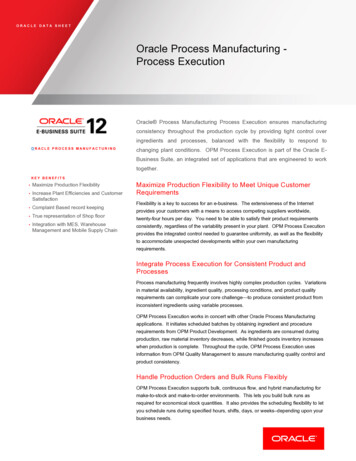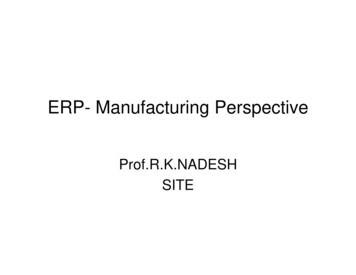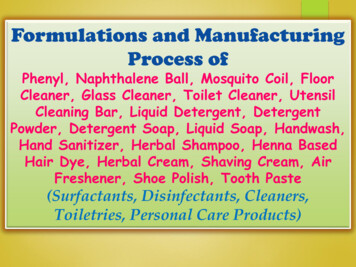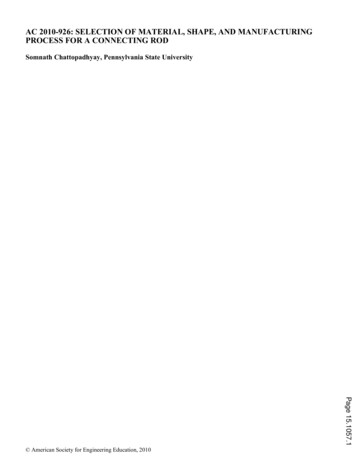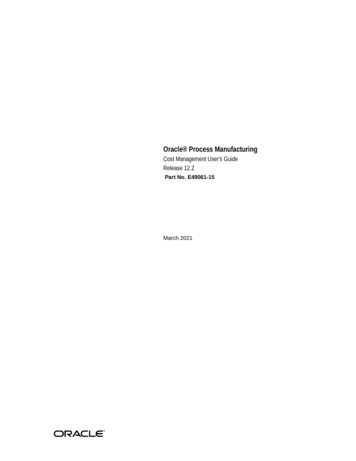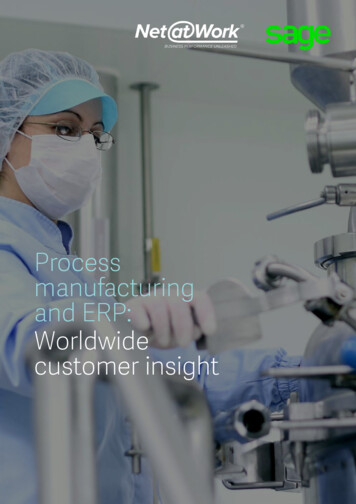
Transcription
Processmanufacturingand ERP:Worldwidecustomer insight
ContentspageIntroduction3What are the challenges facingprocess manufacturers?4What should you look for in an ERP system?6What are the barriers to purchasingERP solutions?8How can you get the right solution?10The reality of process manufacturing and ERP11 2015 Sage Software, Inc. All rights reserved. Sage, the Sage logos, and the Sage product and service namesmentioned herein are registered trademarks or trademarks of Sage Software, Inc., or its affiliated entities.All other trademarks are the property of their respective owners.
IntroductionThe 2013 global economic narrative was largely oneof recovery and growth, causing process manufacturersto breathe a small sigh of relief. However, the term‘recovery’ can often mask an array of challenges facedby organisations as they try to expand their business.Ageing infrastructure, high costs,reduced lead times and a need forimproved visibility are continuing tomake the environment a tricky one forprocess manufacturers as the globaleconomy tries to transition back intoone of growth. Add into the mix theintroduction of new environmentaland safety standards over recent yearsthat require additional managementand controls, not to mention pressureto improve customer satisfaction, andsuddenly the process manufacturingstory looks entirely different.The question now is what are conditionsreally like for process manufacturerspost-financial crisis and how arebusinesses managing to achieve thegrowth they need to complete therecovery process?Customer insights suggest firms needsoftware that can help them raise theproductivity bar, break new ground andensure compliance, if they want to stayahead of the competition. Worldwide,process manufacturing executives arefocusing on solutions that can helpthem address all of their pain pointssimultaneously.The information system and its underlyingEnterprise Resource Planning (ERP)software represents a major step forwardin getting businesses where they need tobe. Companies can install an ERP solutionto not only meet their operational needs,but also streamline their IT infrastructureand deliver support when pursuingnew strategies. However, getting theright solution is half of the battle andexperience suggests that success isdown to procuring software from theright provider.Here, Cateno Barberi, ProductManagement and Process Manufacturingexpert at Sage Mid-Market Europe andPascal Boursier, expert in ERP from Sage’sproduct marketing division for Sage X3,draw on customer feedback to illustratethe challenges process manufacturersare currently facing. Using best practiceexamples, they address how to buy andproperly utilise an ERP system, and whatbarriers companies must overcome whentrying to purchase such a solution.Process manufacturing definedThe simplest definition of processmanufacturing is defined by productsthat, once manufactured, cannotbe distilled back into their originalcomponents.Examples of process manufacturingare: wine production, soft drinks, plasticproducts, etc. For instance, once thegrapes have been crushed and the otheringredients added, you can no longerreturn the grape to its original form.
Process manufacturing and ERP:Worldwide customer insightWhat are the challengesfacing process manufacturers?Cateno Barberi (CB): Processmanufacturers now need to use allof their energy just to stay competitivein the mid-market space, as ageinginfrastructure, customer demands andincreasing costs continue to create dailychallenges.A study from the Economist IntelligenceUnit1 showed 87 percent of executivesfrom across the globe have hadoperations affected by out-of-dateinfrastructure. New technologies that canidentify issues with infrastructure beforethey occur will be needed by firms to putthem on a firm footing for the future. Suchsoftware will help organisations improveefficiency, extend the life of assets,reduce the risk of failure and improve theability of businesses to meet customerexpectations and demand.For example, Blount Fine Foods providerof food for retail customers and one ofSage X3 customers, is able to use theinsight it gains from its ERP solution tomake strategic decisions, analysingproduction data from many angles andtargeting areas for improvement.Being able to evolve and adapt in this waywill be integral as customer needs alter.Indeed, demands are already changingand the last year has seen increasedpressure placed on development times– a trend that will continue to be acompetitive barrier for firms in 2014.This became clear in 2012, when over50 percent of food and drinks firms gotnew products to market in Q2 alone2.Meanwhile, in June 2013 the New YorkTimes3 reported that pharmaceuticalcompanies were being pushed to speedup development of the approval ofnew antibiotics, following outbreaksof resistant superbugs.1234Shire Pharmaceuticals, drugs producerand distributor, is a company thatidentified an historical inability to makechanges quick enough. It was unableto get new acquisitions up and runningon a common finance system swiftly– a failure that threatened its abilityto grow.As it expanded, Shire Pharmaceuticalsneeded to make labour intensive tasksmore efficient and accurate, streamliningprocesses to allow people to focuson the highest value tasks, be agilewhen accommodating new operatingcompanies, and manage‘key man dependencies’.To address the problem, the firm switchedto Sage X3. Using the solution, ShirePharmaceuticals is now able to run a“consistent chart of accounts across thebusiness and provide a robust way ofcontrolling processes and reporting”. Thisvisibility helps Shire Pharmaceuticalsalign innovation strategy with businessstrategy, resulting in shorter times forgetting products to market, withoutcompromising on quality.Nevertheless, pressure to get newproducts to market swiftly has costimplications for businesses. Deloitteidentified in its ‘Global CEO Survey: 2013Country manufacturing competitivenessindex rankings’4, that cost, availability oflabour, materials, cost competitiveness ofmaterials and availability of raw materialsis now the third biggest competitivenessdriver for manufacturers, with an indexreading of 8.07.Global compliance“Using Sage X3 in our smallto medium sized Europeansubsidiaries, means we nolonger have to ask individualsto run reports for us fromdisparate systems – we cannow run reports centrallywhen and where needed, in aconsistent format”Gillian Poor, IT Director,Shire PharmaceuticalsModern manufacturingsolution“Sage X3 is providing theprocess manufacturingfunctionality we needed,and with integrated sales,inventory and financialreports, we have real-timeaccess to data.”Phil Pitzer, IS Director,Blount Fine t/files/EIU Oracle infrastructure Final WEB 2.pdfhttp://www.fdf.org.uk/news.aspx?article l? r Local%20Assets/Documents/us pip GMCI%20report%20highlights 12122012.pdf
Rising outgoings will significantlyaffect profits, especially for mid-marketcompanies. Research from PrimeAdvantage5 in the US showed small andmid-market manufacturers were lessconfident about their finances in 2013.Indeed, just 64 percent of executivessaid they were optimistic about theircompany’s financial prospects, comparedto 69 percent the year before.Pascal Boursier (PB): On top of their mainbusiness process issues – recovery willdemand that manufacturers gain newcustomers. Ten percent of companiesare expecting significant growth in thefuture, according to the ManufacturersAssociation7, and it is clear firms want togrow. What’s more, they want to bettercontrol their costs, reduce their operatingmargins and increase their productivity.Yet, broadly there is optimism in themanufacturing industry. According to theManufacturers Association6, 70 percentof firms forecast an improvement in thecoming year. However, just six percentexpect significant improvements,suggesting a modest 2014.Sage X3 can help achieve this andhas already allowed Ganong Bros.Limited, a producer of chocolate andconfectioneries in Canada, to analyseits profitability. Using the solution it isable to factor cost contributors into itsfinancial reporting. Such analysis helpsthe company make strategic pricingand product mix decisions. “BeforeSage X3, we were not able to see thewhole picture,” Marc Lefebvre, VicePresident and Chief Information Officerfor Ganong, said. “We are able to clearlysee which products and customers aremost profitable for us.”Meanwhile, managing the quality processand meeting safety standards will beessential for process manufacturers.Features that limit liability will improve theend product through consistent qualitymetrics.New environmental and safety standardsin the manufacturing domain alsorequired additional management andcontrols to be introduced. Among themany changes creating challenges forfirms are the revisions to the currentHazard Communication Standard (HCS)to align with the United Nations’ GloballyHarmonized System of Classification andLabeling of Chemicals (GHS)(timeline 2015).Blount Fine Foods used Sage X3 to ensureit could better control processes. Itsprevious system was limited and managedformulas, recipes, and work orders ina Microsoft Access database, whichfew had access to. Sage X3 is a scalablesolution for the firm, enabling it to tailorsystem behaviour and content withoutmaking program changes. This meansthat the company didn’t have to be at themercy of an outside programmer to makechanges to the software as the businessevolved.567Blount Fine Foods has also used SageX3 to drive expansion. Louise Goodman,Corporation Controller for the company,said: “The advanced technology, easeof use, and right-sized implementationmethodology of Sage X3 positions BlountFine Foods for future growth.”Phil Pitzer, Information Systems Directorfor Blount Fine Foods, added: “Wehave a great deal of confidence in theproduct. Ultimately, Sage X3 works sowell for us because it allows us to focuson producing a quality product, not onmaintaining our ERP software. We havedoubled our revenues since implementingSage X3 and it continues to offer a goodcombination of power, scalability, ww.fdf.org.uk/event.aspx?event 3761Exceptional standardsof quality“We used to manage ourquality control processesentirely outside of thesoftware, but with Sage X3,it now is an integral part ofour manufacturing process”.Marc Lefebvre, Vice President and CIOGanong Bros. Limited
Process manufacturing and ERP:Worldwide customer insightWhat should you look forin an ERP system?CB: Customers recognise that ERPsolutions can help them overcome thebarriers they are likely to face in the future,but the key is getting the right one. Besure to look for an ERP solution with astrong process manufacturing foundationthat supports many of the best practicesrequired to align business processes.These include:Formula/recipe management – TheFDF and the British Automation andRobot Association is pushing for greaterautomation when it comes to formulaand recipe management8. However, in2012 it was observed that UK companieslag behind their European counterpartsin adopting automation. Customersclaim this can cause barriers on the wayto growth. Once King Pie implementedformula/recipe management via SageX3, for example, it was able to manageall aspects of sales, stock control andinventory management using onesolution.Quality control – This allows firms torecord quality specifications for differentproducts. With this information, acompany will be able to track and recordthe quality of materials. The significanceof this was demonstrated by GanongBros. Limited. Historically, the companyused to manage quality control processesoutside of ERP software but it adoptedSage X3 and has now integrated qualitymanagement into its operations. Thequality management application sends amessage to the quality control staff whenraw materials are received, includingthe product number, lot number, andwarehouse location.Lot tracking and traceability – Tiedto quality management, this functionrecords the identity of any ingredient orproduct that is lot-controlled. A companycan use this to meet industry andgovernment regulations for warranties89and quality assurance. It also allows aprocess manufacturer to assign inventoryfrom a lot on demand to meet specificconsumer needs.Serialisation and traceability is importantfor pharmaceutical companies and around50 percent of firms are already dealingwith this via their manufacturingprocesses9. To remain competitive,companies will need to be able to provethey have this level of visibility withinpractices by adopting the right solution.Anthony Loheas, Industrial ManagementController for Délices de Saint-Léonard,said: “Sage X3’s arrival helped us towork more obligatorily, by benefitingfrom integrated and coherent data. It’simpossible to send products if they arenot present in the stock! It’s impossibleto charge if price lists are not created!Thanks to Sage X3, our stocks of rawmaterials, packagings or finished productsare now completely reliable, allowing us toguarantee the upstream traceability andthe approval of our goods. How does ERPmake things easier? From the materialto the finished product, and from thefinished product up to the end customer,everything is tracked.”Comprehensive capabilities“Sage X3 fully integrates withour existing distribution,trading, manufacturing,project implementationand unit servicing. It wasdeployed using our existingstaff compliment and wasfinalised within the specifiedtime period, which wasimpressive”Hennie Terreblanche,CFO of King PieProduction schedule management– This uses criteria such as shifts,hours,
Process manufacturing defined The simplest definition of process manufacturing is defined by products that, once manufactured, cannot be distilled back into their original components. Examples of process manufacturing are: wine production, soft drinks, plastic products, etc. For instance, once the grapes have been crushed and the other

